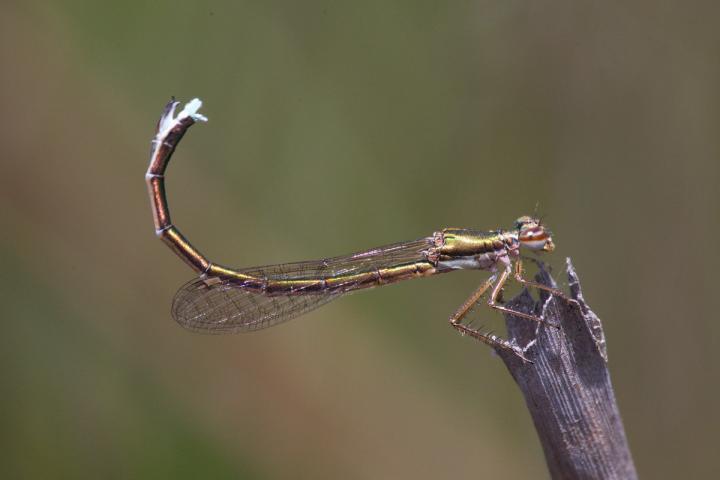
Hemiphlebia mirabilis is a rare species in every sense: it is the most primitive dragonfly known to man, it has unique reproductive behaviors and was believed to be extinct. The dragonfly considered the most primitive in the world lives in Australia and Tasmania, and was believed to be extinct four decades ago. But it is far from being so. A Spanish researcher has observed thousands of these insects in one of the few habitats in which it has been detected and it displays sexual behaviour that is unique, not only directed towards reproduction.
Hemiphlebia mirabilis is a rare species in every sense: it is the most primitive dragonfly known to man, it has unique reproductive behaviours and was believed to be extinct in the 70s. Fascinated by this living fossil, researcher Adolfo Cordero-Rivera travelled to Australia, where it is endemic, to gather information on the mating system of a population that started to be seen again in 2009.
After an intensive month of observations, the researcher in the University of Vigo (Spain) showed that the species is far from being extinct: "I found thousands of individuals, which is very good news since there was much concern for this species." As he explains in the journal Insect Conservation and Diversity.
Although the work aimed to obtain basic information on the reproductive behaviour of this dragonfly and study the development of the sperm competition mechanisms in this very primitive species, the scientist also shows that, contrary to what was believed, the populations are large. "The number of individuals per generation possibly exceeds 1 million," he states in the study.
This population that lives in the Long Swamp wetland in Victoria, in the south of Australia, has a life expectancy of one week for the males and four days for the females. Moreover, the males show little mobility and fly short distances, remaining inactive most of the time, especially in temperatures below 17ºC or above 35ºC.
"This low mobility, together with its enigmatic colouring and the limited accessibility of its habitat could explain how these important populations have remained unnoticed until a very short while ago," Cordero-Rivera told SINC. Despite having experienced certain limitations due to carrying out the research alone, the expert could estimate a density of 100 animals for each 10 m2 in points of high population.
For this reason, Cordero-Rivera suggests that this species of dragonfly should no longer be considered a species in critical danger of extinction. "With the information now available, Hemiphlebia mirabilis no longer satisfies any of the criteria of the International Union for Conservation of Nature and should be re-evaluated," says the researcher.
Unique sexual behaviour
But the aspect which undoubtedly makes them more visible to the human eye is their sexual behaviour. What surprised the researcher most was that both sexes showed frequent abdominal flicking displays and fast rotations over the perching support. "This behaviour is highly elaborate and is absolutely unique," says the scientist from the Galician university who immortalised the movements in video. The copulation behaviour has been analysed in a second article that has just been published in the journal PeerJ.
This work is the first to quantify adult behaviour of the Hemiphlebia mirabilis using a large sample of both sexes. When studying these insects, the scientist observed that the unique movement is not only produced immediately after landing, but also while they continue to sit.
Although Cordero-Rivera could not confirm whether the females and males use this abdominal flicking to attract the opposite sex, he could confirm that both sexes practice this movement even in the absence of any reproductive interaction.
"This suggests that this behaviour is not an ordinary courtship display," affirmed the scientist. According to the researcher, the males use the abdominal movement in the pre-copulatory courtship, but the females don't. After more than 100 hours of observation, the scientist did not see any of the females lay eggs.
"I observed 79 females for periods of 10 minutes between 9:00am and 7:00pm, and the only clear conclusion is that oviposition will not be in tandem, because in all cases males and females separated immediately after copulation," says the scientist who is continuing with the study of sexual behaviour of this peculiar and unique dragonfly.
What has been demonstrated is that, like the most recent species of the Odonata order, the male H. mirabilis are capable of extracting the semen of rivals from inside the body of the female. "This suggests that this much specialised behaviour is very old in the evolution of the Odonata," he concludes.
Source: FECYT - Spanish Foundation for Science and Technology
 Print Article
Print Article Mail to a Friend
Mail to a Friend
